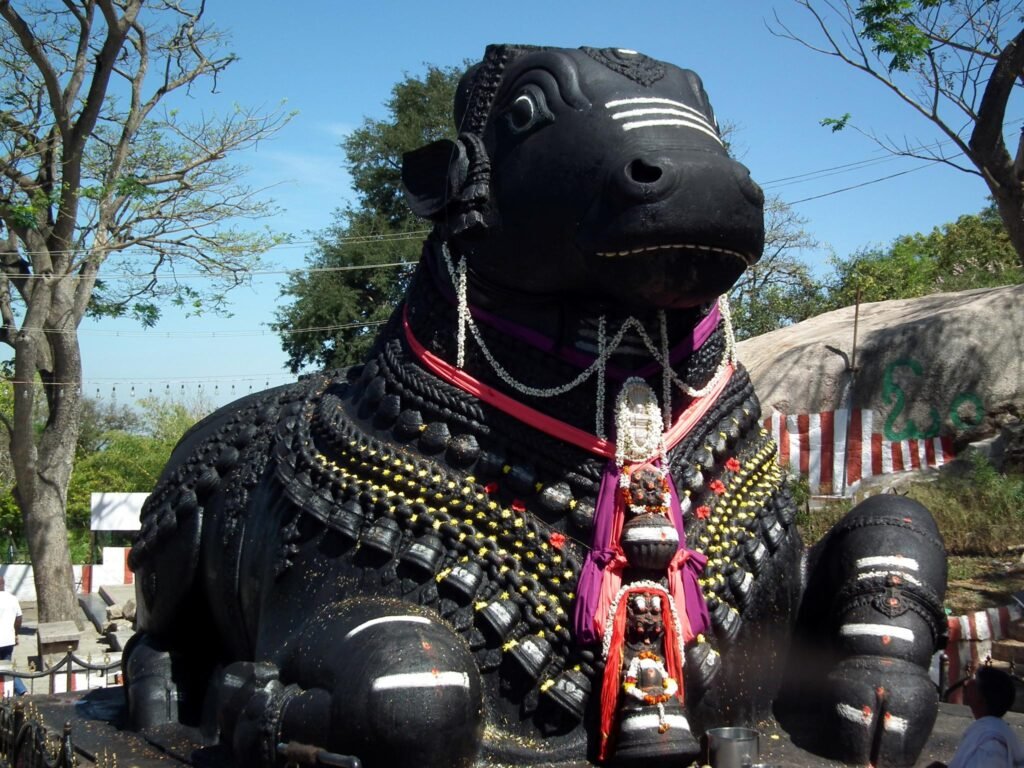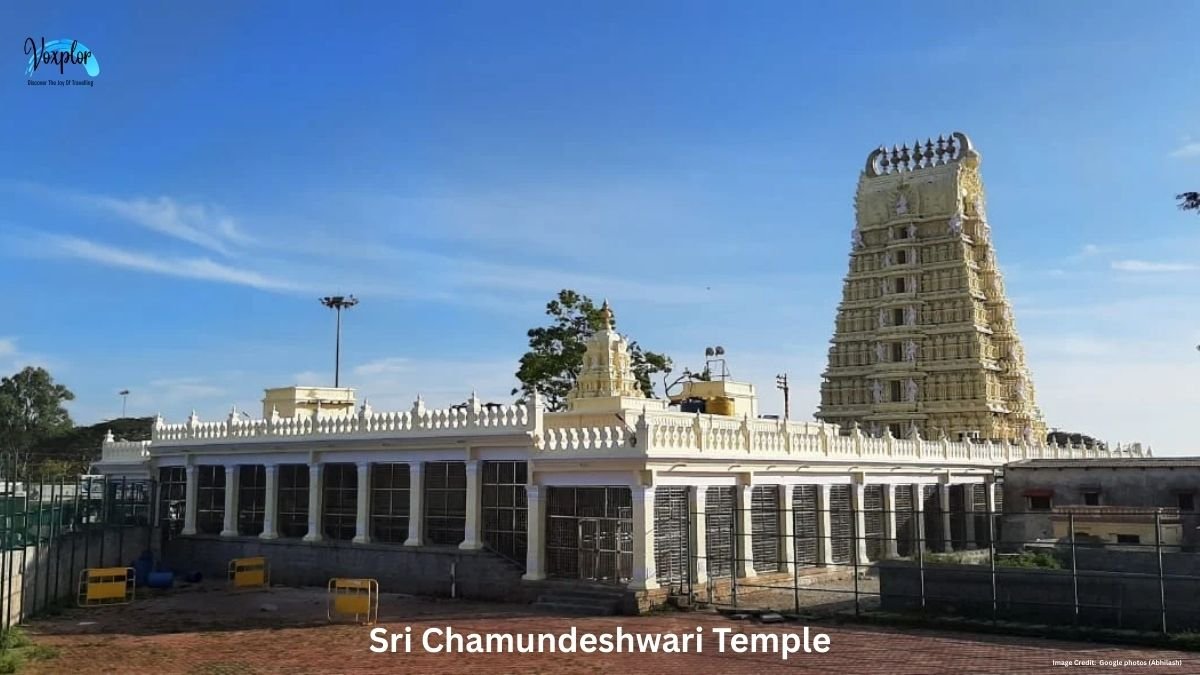Some places are just spots on a map. Others are the very soul of a city. High above the elegant, palace-strewn city of Mysore, perched atop a granite hill that has watched over its people for a thousand years, sits one such soul: The Chamundeshwari Temple.
This isn’t just a temple; it’s a spiritual anchor, a fortress of faith, and the home of the fierce, yet compassionate, goddess who gave Mysore its name. I’ve travelled to many powerful religious sites, but the energy on Chamundi Hills is something else entirely. It’s a palpable presence, a blend of royal history, fierce mythology, and the unwavering devotion of millions.
I’d seen the temple from afar on previous trips to Mysore, a distant gold speck glinting in the sun, always promising a story. Last monsoon, I decided it was finally time to make the pilgrimage, not just as a tourist, but as a seeker. This guide is the fruit of that journey—a deep dive into the legends, the architecture, the rituals, and the feeling of standing in the presence of Mysore’s eternal guardian.
About the Author:Hi, I’m V. My passion is exploring the spiritual tapestry of India, from remote Himalayan shrines to the grand temple complexes of the South. I believe that every temple has a story to tell, and my goal is to listen. The Chamundeshwari Temple had been on my list for years, and experiencing its power and history first-hand was a truly humbling journey. This guide is my attempt to share that profound experience with you.
The Legend That Forged a City: Why This Chamundeshwari Temple Exists
To understand the temple, you must first understand the epic battle that gave it life. The story is a cornerstone of Hindu mythology and the very reason Mysore is called Mysore.
Long ago, this region was terrorized by the buffalo-headed demon king, Mahishasura. Through intense penance, he had obtained a boon from Lord Brahma that made him invincible—no man or god could kill him. Drunk on this power, he waged war on the heavens, defeated the gods, and established a reign of terror on earth.
In desperation, the gods pooled their divine energies, creating a warrior goddess of unimaginable power and beauty: Durga. Each god gifted her their most powerful weapon. Armed and riding a fierce lion, she challenged Mahishasura to a battle that raged for nine days and nine nights. On the tenth day, the day of Vijayadashami, she finally vanquished the demon on the very hill where the temple now stands.
For this victorious feat, she earned the name Mahishasura Mardini (The Slayer of Mahishasura). She is also known as Chamundeshwari, the fierce form of the divine mother. The city below, once known as Mahishuru, was named Mysuru in his honor after he repented before his death. The hill, forever sacred, became Chamundi Hills.
Walking on this land, knowing this story, changes everything. You aren’t just on a hill; you’re on a celestial battlefield where good triumphed over evil.
Karmanghat Hanuman Temple: History, Timings & A Complete Guide (2025)

A Royal Patronage: The Wadiyar Dynasty’s Enduring Devotion
The temple’s history is inextricably linked with the Wadiyar kings, the erstwhile rulers of the Kingdom of Mysore. Chamundeshwari wasn’t just a deity they worshipped; she was their Kuladevi, the patron and guardian goddess of their royal family.
While the temple’s origins are believed to be over 1,000 years old, it was the Wadiyars who transformed it into the grand structure we see today.
- In 1659, King Dodda Devaraja Wadiyar commissioned the famous 1,000 steps leading up the hill, a monumental act of devotion.
- In 1827, King Krishnaraja Wadiyar III renovated the temple and constructed the magnificent seven-story, 40-meter-high Gopuram (entrance tower), a masterpiece of Dravidian architecture.
Their patronage is visible everywhere, from inscriptions to donations. It’s a testament to a bond between rulers and their guardian goddess that has shaped the destiny of the region.

My First-Hand Walkthrough: Experiencing the Temple’s Sacred Spaces
There are two ways to approach the goddess: the winding road or the ancient stone steps. While I took the road for my first visit, I knew I had to experience the pilgrimage of the steps later.
The First Glimpse and the Temple Exterior
As you arrive at the summit, the first thing that commands your attention is the towering Gopuram. It’s a riot of color and sculpture, a vertical narrative of gods, goddesses, and celestial beings. As I stood before it, the sound of temple bells and the scent of incense and camphor already filled the air, pulling me in.
Before entering, I took a moment to admire the massive, silver-plated doors of the main entrance. The architecture is a beautiful example of the Dravidian style, with a large courtyard surrounding the main shrine.
Inside the Sanctum: A Moment with the Goddess
The queue moves slowly, building anticipation. The air inside is thick with the energy of centuries of prayer. As you get closer, you hear the priests’ Sanskrit chants resonating off the ancient stone walls.
And then, you are in her presence.
The idol of Chamundeshwari is made of gold, and she is depicted in her fierce, eight-armed form (Ashta Bhujas), slaying the demon Mahishasura. Despite the formidable depiction, what I felt was not fear, but a profound sense of maternal power and protection. The goddess is adorned with exquisite silks and brilliant jewelry, her eyes shining with a divine light in the flickering glow of oil lamps. You only get a few moments in front of the sanctum, but it’s enough. It’s a powerful, centering experience that stays with you.
Beyond the Main Shrine: Exploring the Sacred Hill
A visit to Chamundi Hills is incomplete without exploring its other sacred and scenic spots.
1. The Pilgrimage of 1,000 Steps and the Great Nandi
For the able-bodied, I cannot recommend this enough. The climb up the 1,000 stone steps is a pilgrimage in itself. It’s a journey taken by devotees for centuries, a physical act of devotion.
About 800 steps up, you are greeted by one of South India’s most magnificent sights: the Nandi Statue. Carved from a single massive boulder of black granite, this 15-foot-high, 24-foot-long monolith of Shiva’s bull is breathtaking in its scale and craftsmanship. It’s a serene, powerful spot to rest, catch your breath, and marvel at the artistry.
2. The Mahishasura and Nandi Statues at the Summit
Near the temple entrance, you’ll find the iconic, brightly painted statue of Mahishasura, holding a sword and a cobra. It’s a striking, larger-than-life depiction of the demon and a favorite photo spot for visitors.
3. The View of Mysore City
Walk a little past the temple complex to the designated viewpoint. From here, you get a stunning panoramic view of the entire city of Mysore laid out below you like a map. You can spot the Mysore Palace, the Race Course, and Lalitha Mahal Palace.
Blogger’s Tip: The view is especially beautiful just after a rain shower when the air is clear, or at night when the city lights up. The Mysore Palace is illuminated on Sundays and public holidays, and seeing it from the hill is pure magic.
A Practical Guide for a Divine Experience
Temple Timings: Plan Your Visit Carefully
- Darshan Timings: 7:30 AM to 2:00 PM, 3:30 PM to 6:00 PM, and 7:30 PM to 9:00 PM.
- Abhisheka Timings: 6:00 AM to 7:30 AM and 6:00 PM to 7:30 PM. (On Fridays: 5:00 AM to 6:30 AM).
My Advice: The temple is extremely crowded on Fridays, Sundays, public holidays, and during the holy month of Ashada. If you want a more peaceful experience, visit on a weekday. Go early in the morning to experience the divine morning rituals and beat the crowds.
Darshan and Pujas
- General Darshan: This is the free queue and can be very long, especially on peak days.
- Special Entry Darshan: You can buy tickets (usually ₹30 and ₹100) for a much faster darshan. If you are short on time, I highly recommend this.
Dress Code
There is a strict dress code. It’s a sacred place, so dress modestly.
- Recommended: Sarees, salwar kameez, kurtas, dhotis, trousers, shirts.
- What to Avoid: Shorts, miniskirts, sleeveless tops, and revealing clothing. As a general rule, cover your shoulders and knees.
How to Reach Chamundi Hills
- By City Bus: KSRTC operates regular buses (Bus No. 201) from the Mysore City Bus Stand to the top of the hill. This is the most economical option.
- By Taxi/Auto-Rickshaw: You can hire a cab or auto for a round trip. It’s convenient but more expensive.
- By Foot: Climb the 1,000 steps for the full pilgrimage experience. It takes about 45-60 minutes for a person of average fitness.
Dasara: When the Goddess is the Queen of the Kingdom
The world-famous Mysuru Dasara is a 10-day festival celebrating Chamundeshwari’s victory over Mahishasura. During this time, the temple is the epicenter of all festivities. The royal family of Mysore performs special pujas, and the entire city celebrates. The grand finale is the Jumboo Savari, a magnificent procession of caparisoned elephants carrying the idol of the goddess through the city streets. Visiting during Dasara is a chaotic, vibrant, and unforgettable experience.
Frequently Asked Questions (From a Traveler’s Notebook)
Is photography allowed?
Photography is strictly prohibited inside the main temple sanctum. You can take photos in the outer courtyards and of the temple’s exterior.
How much time is needed for a visit?
Budget at least 2-3 hours for a complete visit, including darshan and exploring the surroundings. If you plan to climb the steps, add another 2 hours.
Are there facilities for senior citizens?
Yes, vehicles can go right up to the temple entrance. There are also wheelchair facilities available for those in need. The special entry queue is much shorter and advisable for the elderly.
Final Thoughts: The Ever-Watchful Guardian
Leaving Chamundi Hills, I felt a sense of serene power. The Chamundeshwari Temple is more than a historic monument or a tourist attraction. It is the living, breathing heart of Mysore. It’s a place where myth feels like history, where royal devotion is carved in stone, and where you can feel the unwavering presence of a goddess who has guarded her city and its people for a millennium.
Whether you climb its thousand steps as an act of faith or drive up to witness its architectural grandeur, you will leave with the feeling that you have truly been in the presence of a queen.


